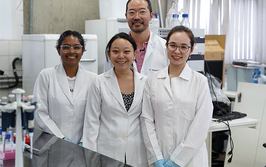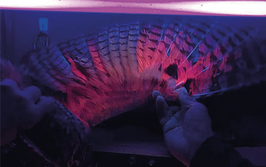What’s New in (Bio)Pharma?
Putting COVID-19 on a diet, native ambient MS aids drug discovery, and elucidating monoclonal antibody structure with IMS-MS…
Lauren Robertson | | News

Putting COVID-19 on a diet
It turns out SARS-CoV-2 loves fat. Like, a lot. Based on observations that some people with a higher body-mass index were more sensitive to COVID-19, researchers from Oregon Health & Science University and the Department of Energy’s Pacific Northwest National Laboratory decided to use nontargeted lipidomics to look a little closer at how the virus alters lipid levels in cells. What they saw was a massive shift, with some fats increasing 64-fold. Further research revealed the virus completely takes over the fat-processing system in the body. Based on this discovery, the team decided to put the virus on a diet – pumping it with weight-loss drugs (small-molecule glycerolipid biosynthesis inhibitors) to cut off its fuel supply and stop it replicating. Crucially, the authors found this inhibition works across the main variants of concern, meaning this approach could continue to work as the virus evolves.
Combating hunger
Talking of diets, have researchers just discovered the latest, greatest diet pill? Perhaps. Jonathan Long and his team published a study showing that exercise induces the production of Lac-Phe – an “anti-hunger” molecule that appears to suppress appetite post-exercise (at least in mice). Using MS, the team studied how the metabolome shifted and changed during exercise, and eventually honed in on one peak in particular with a mass of 236. Thanks to some collaborative work with a team at Stanford University, they were able to decipher that this molecule was a combination of lactate and phenylalanine. They even went further and fed this molecule to obese mice, finding that their food intake dropped by about 30 percent. The next steps are to elucidate the mechanism behind this activity.
A boon for drug discovery
Drug discovery just got a new best friend in the shape native ambient MS. By applying this technique to the analysis of non-covalent protein-drug complexes in vivo, researchers have managed to gather more information about drug-target interactions in their native physiological environment. “Using mass spectrometry on proteins is often compared to making an elephant fly.,” said lead researcher Helen Cooper. “What we’ve done is add an unsecured hat – the drug molecule – to the elephant, and measured the whole process. It’s exciting because it opens up the possibility of being able to follow the route of a drug through the body. By identifying which proteins it interacts with, scientists will be able to predict at an earlier stage whether or not it will have the desired therapeutic effect.” The hope is that this same technique can next be applied to human tissues, and that it will help guide drug discovery efforts in the future.
Also in the News...
IMS-MS approach elucidates higher order structures of monoclonal antibodies. Link
Cyclic ion mobility MS reveals localization of aspartic acid isomerization to isoaspartic acid in therapeutic peptides. Link
Quantitative chemical proteomics assay reveals off-target landscape of histone deacetylase (HDAC) drugs. Link
Quantitative MS-based succinylproteomics analysis of SARS-CoV-2 infection reveals host protein posttranslational pathways that could provide potential antiviral drug targets. Link
Open-access research article explores application of sub/supercritical fluid chromatography for biomolecules and how it can fingerprint complex peptides. Link
Sapient receives US$9.2 million grant from the Bill & Melinda Gates Foundation to use its rapid liquid chromatography-mass spectrometry platforms for population-scale discovery metabolomics analysis. Link
Merck Group collaborates with Agilent to advance Process Analytical Technologies for downstream bioprocessing. Link
By the time I finished my degree in Microbiology I had come to one conclusion – I did not want to work in a lab. Instead, I decided to move to the south of Spain to teach English. After two brilliant years, I realized that I missed science, and what I really enjoyed was communicating scientific ideas – whether that be to four-year-olds or mature professionals. On returning to England I landed a role in science writing and found it combined my passions perfectly. Now at Texere, I get to hone these skills every day by writing about the latest research in an exciting, creative way.

















